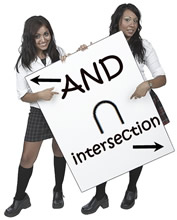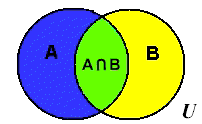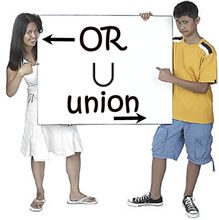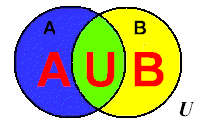|
This section will take a look at probability involving the concepts of "AND" and "OR".
It will be observed that there is a working relationship between set theory and probability.
In probability, an outcome is in event "A and B"
only when the outcome is in both event A and event B.
(Intersection)
|
|
In a Venn Diagram, an element is in the intersection of "A and B" only when the element is in BOTH sets. |
Rule (for AND): 
|
n(A and B) means the number of outcomes in both A and B.
n(S) means the total number of possible outcomes (the sample space).

A dice is rolled. What is the probability that the number is even and less than 4? |
Solution:
Event A: Numbers on a die that are even: 2, 4, 6
Event B: Numbers on a die that are less than 4: 1, 2, 3
There is only one number (2) that is in both events A and B.
Total outcomes S: Numbers on a die: 1, 2, 3, 4, 5, 6 (total = 6)
Answer: Probability = 1/6 |
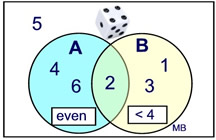 |

In probability, an outcome is in event "A or B"
when the outcome is in either (or both)
event A and event B.
(Union)
|
|
In a Venn Diagram, an element is in the union of "A or B" only when the element is in set A or set B or BOTH sets. |
Rules (for OR): (two versions) 
(may be referred to as the "Probability Addition Rule") |
The rule for OR must take into account values that may get counted more than once where the sets overlap.
In the first version, this overlap is dealt with when finding n(A or B).
In the second version, this overlap is dealt with in the subtraction of the intersection, P(A and B).
If sets A and B are mutually exclusive (no elements in common), P(A and B) = 0,
making the second formula simply P(A or B) = P(A) + P(B).

A die is rolled. What is the probability that the number is even or less than 4? |
Solution:
Event A: Numbers on a die that are even: 2, 4, 6 P(A) = 3/6
Event B: Numbers on a die that are less than 4: 1, 2, 3
P(B) = 3/6
Probability P(A and B) = 1/6 (see rule above)
Answer: Probability = P(A) + P(B) - P(A and B)
= 3/6 + 3/6 - 1/6 = 5/6 |
 |
| ** Notice in this problem that the number 2 appears in both event A and event B. If we did not subtract the P(A and B), the answer would be 1, which we know is not true since the number 5 appears in neither event. |
|

NOTE: The re-posting of materials (in part or whole) from this site to the Internet
is copyright violation
and is not considered "fair use" for educators. Please read the "Terms of Use". |
|
|

